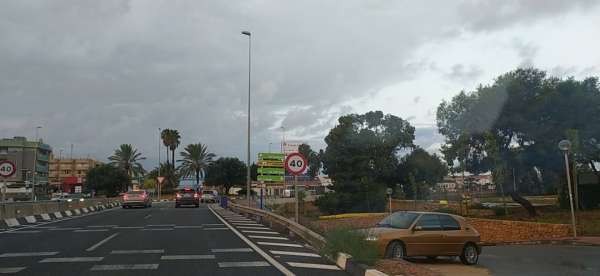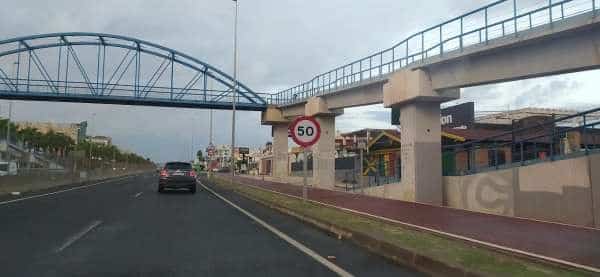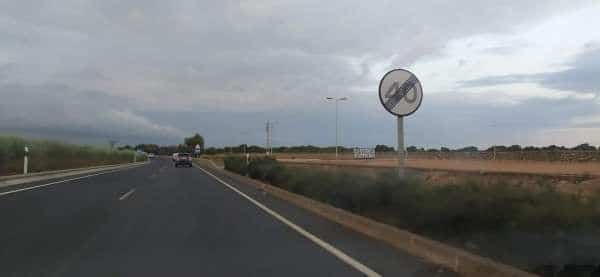This week, a newspaper reported a story about a driver who had been fined multiple times for speeding on the N-332 on the Orihuela Costa, a story that was subsequently repeated by a number of other news and media publications and websites.
See Article: Challenge to N332 Speed Limit in Campoamor
The article raised a number of questions, which we will now clarify, but before we look at both the reported case and the current laws, let us look at the road in question.
We are heading along the N-332 in the direction of Cartegena. These pictures were all taken by the passenger in the vehicle, to avoid any doubt. You can read the description underneath each picture.










Now we have seen the road in question, we can look at the complaint that was raised in the newspapers.
A taxi driver received multiple sanctions for speeding along the stretch of road. The complainant stated to the press that the speed limit on the road should be 100 kilometres per hour, because the width of the hard shoulder is greater than 1.6 metres, therefore disputing the sanctions.
However, as we reported at the time, as of Tuesday 29 January 2019, new maximum permitted speed limits came into force on certain roads in Spain. This new law replaced the one where the width of the hard shoulder was relevant. That ruling no longer applies.
Moreover, when the law was changed in 2019, the generic maximum permitted speed on conventional roads was reduced to a maximum of 90 kilometres per hour, so both parts of this claim are incorrect.
It is possible that conventional roads can have a maximum permitted speed of 100 kilometres per hour, but this is now the exception, and in the event, it must be clearly signposted as such, which we can see from the pictures above, is not the case.
Article 48 of the relevant traffic law deals with this (Artículo 48. Velocidades máximas, en vías fuera de poblado).
If you would like to see an example of where this does apply, the modernised N-332 as it passes Benidorm does have a maximum permitted speed of 100 kilometres per hour in some sections, but the signs clearly indicate when this is the case.
When we talk about generic speed limits, we are referring to roads, normally outside towns, where no other restrictions are in force, or, in other words, where there are no signs indicating otherwise. The concept of this, for British drivers, is similar to the National Speed Limit Applies in the UK, although unlike the UK, there is no sign that indicates this is the case.
Next, let us look at the sanctions the driver received, which have been blacked out to protect personal and sensitive data.
In the sanction (below) we can see, it shows that the driver was in fact recorded at 108 kilometres per hour. Therefore, in any case, even if the driver incorrectly believed that the maximum permitted speed was 100 kilometres per hour, he was still driving in excess of that speed, even allowing for a margin of error (a topic we will deal with on another occasion). There is no justification for travelling at 108 kilometres per hour on a conventional road.

Now, although we said, and stand by the fact, that nothing justifies a speed of 108 kilometres per hour on a conventional road, if we look closely at the sanction, we see another point which is of interest (below).

The sanction actually says that the offence was committed on a section of road where the limit is 80 kilometres per hour, and, importantly, it says there are signs indicating this.
If we look back over the pictures, we can see that there are no signs that indicate a maximum permitted speed limit of 80 kilometres per hour. Therefore, this is a mistake by the issuing authority. If the driver had been recorded doing 90 kilometres per hour in this section, this could be grounds to appeal the fine, but, alas, it still does not justify doing 108 kilometres per hour.
So, what is the maximum permitted speed?
As we already alluded to, Article 48 of the traffic law refers to maximum speeds on roads outside towns. This is again referring to roads where no other restrictions are in force, so no signs exist.
According to the law, the maximum speeds that must not be exceeded, except in the cases provided for in article 51, for cars, motorcycles, motorhomes with a maximum authorised mass of less than 3,500 kg, 90 kilometres per hour. There are other restrictions, but we are referring to cars in relevance to this case.
As we have also said, the law states that on conventional roads with physical separation of the two directions of traffic, the owner of the road may set a maximum limit of 100 km/h for cars, motorcycles and motorhomes with a maximum authorised mass equal to or less than 3,500 kg. But this is the exception and must be clearly signposted.




